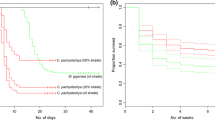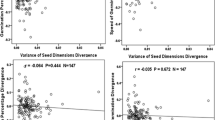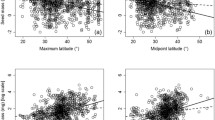Abstract
The response of seed germination towards light and the relationship to seed traits has been studied particularly well in tropical forests. Several authors have shown a clear adaptive response of seed size and photoblastism, however, the evolutionary significance of this relationship for species inhabiting arid environments has not been fully understood and only some studies have considered the response in a phylogenetic context. We collected seeds from 54 cacti species spread throughout the tribe Cacteae to test whether there was correlated evolution of photoblastism, seed traits and germination using a reconstructed phylogeny of the tribe. For each species we determined the photoblastic response under controlled conditions, and seed traits, and analyzed the results using phylogenetically independent contrasts. All studied species were positive photoblastic contrasting with the basal Pereskia suggesting an early evolution of this trait. Seeds from basal species were mostly medium-sized, diverging into two groups. Seeds tend to get smaller and lighter suggesting an evolution to smaller sizes. No evidence exists of a relationship between seed size and photoblastic response suggesting that the photoblastic response within members of this tribe is not adaptive though it is phylogenetically fixed and that is coupled with environmental cues that fine tune the germination response.

Similar content being viewed by others
References
Anderson EF (2001) The cactus family. Timber Press, Portland
Ayala-Cordero G, Terrazas T, López-Mata L, Trejo C (2004) Stenocereus beneckei seed mass variation and its relationship to germination. Interciencia 29:692–697
Baker HG (1972) Seed weight in relation to environmental conditions in California. Ecology 53:997–1010
Bakker JP, Poschlod P, Strykstra RJ, Bekker RM, Thompson K (1996) Seed banks and seed dispersal: important topics in restoration ecology. Acta Bot Neerl 45:461–490
Balogh R, Toft CA (2007) Effect of seed size on seedling performance in a long-lived desert perennial shrub (Ericameria nauseosa: Asteraceae). Int J Plant Sci 168:1027–1033
Bárcenas RT, Yesson C, Hawkins JA (2011) Molecular systematics of the Cactaceae. Cladistics 27:470–489
Barthlott W, Hunt D (2000) Seed diversity in the Cactaceae. David Hunt, United Kingdom
Baskin CC, Baskin JM (1998) Seeds: ecology, biogeography, and evolution of dormancy and germination. Academic Press, California
Benítez-Rodríguez JL, Orozco-Segovia A, Rojas-Aréchiga M (2004) Light effect on seed germination on four Mammillaria species from Tehuacán-Cuicatlán Valley, Central Mexico. Southwest Nat 49:11–17
Blomberg SP, Garland T, Ives AR (2003) Testing for phylogenetic signal in comparative data: behavioral traits are more labile. Evolution 57:717–745
Bowers JE (2000) Does Ferocactus wislizeni (Cactaceae) have a between-year seed bank? J Arid Environ 45:197–205
Bowers JE (2005) New evidence for persistent or transient seed banks in three Sonoran desert cacti. Southwest Nat 50:482–487
Butterworth ChA, Cota-Sánchez H, Wallace RS (2002) Molecular systematics of tribe Cacteae (Cactaceae: Cactoideae): a phylogeny based on rpl16 intron sequence variation. Syst Bot 27:257–270
Cerabolini B, Ceriani RM, Caccianiga M, De Andreis R, Raimondi B (2003) Seed size, shape and persistence in soil: a test on Italian flora from Alps to Mediterranean coasts. Seed Sci Res 13:75–85
Cheib AL, García QS (2012) Longevity and germination ecology of seeds of endemic Cactaceae species from high-altitude sites in south-eastern Brazil. Seed Sci Res 22:45–53
Cordazzo CV (2002) Effect of seed mass on germination and growth in three dominant species in southern Brazilian coastal dunes. Br J Biol 62:427–435
Cota JH, Wallace RS (1997) Chloroplast DNA evidence for divergence in Ferocactus and its relationships to North American columnar cacti (Cactaceae: Cactoideae). Syst Bot 22:529–542
Dau L, Labouriau LG (1974) Temperature control of seed germination in Pereskia aculeata Mill. Anais Acad Brasil Cien 46:311–322
Del Castillo RF (1986) Semillas, germinación y establecimiento de Ferocactus histrix. Cact Suc Mex 31:5–11
Eriksson O (1999) Seed size variation and its effect on germination and seedling performance in the clonal herb Convallaria majalis. Acta Oecol 20:61–66
Felsenstein J (1985) Phylogenies and the comparative method. Am Nat 125:1–15
Fenner M (2000) The ecology of regeneration in plant communities. CAB International, London
Fenner M, Thompson K (2005) The ecology of seeds. Cambridge University Press, Cambridge
Flores J, Jurado E, Arredondo A (2006) Effect of light on germination of seeds of Cactaceae from the Chihuahuan Desert, Mexico. Seed Sci Res 16:149–155
Flores J, Jurado E, Chapa-Vargas L, Ceroni-Stuva A, Dávila-Aranda P, Galíndez G, Gurvich D, León-Lobos P, Ordóñez C, Ortega-Baes P, Ramírez-Bullón N, Sandoval A, Seal CE, Ullian T, Pritchard HW (2011) Seeds photoblastism and its relationship with some plant traits in 136 cacti taxa. Environ Exp Bot 71:79–88
Franco A, Nobel P (1989) Effect of nurse plants on the microhabitat and growth of cacti. J Ecol 77:870–886
Gomaa NH, Picó FX (2011) Seed germination, seedling traits, and seed bank of the tree Moringa peregrina (Moringaceae) in a hyper-arid environment. Am J Bot 98:1024–1030
Grime JP, Mason G, Curtis AV, Rodman J, Band SR, Mowforth MAG, Neal AM, Shaw S (1981) A comparative study of germination characteristics in a local flora. J Ecol 69:1017–1059
Gurvich DE, Funes G, Giorgis MA, Demaio P (2008) Germination characteristics of four Argentinean endemic Gymnocalycium (Cactaceae) species with different flowering phenologies. Nat Areas J 28:104–108
Hendrix SD (1984) Variation in seed weight and its effects on germination in Pastinaca sativa L. (Umbelliferae). Am J Bot 71:795–802
Hernández-Hernández T, Hernández HM, De-Nova JA, Puente R, Eguiarte LE, Magallón S (2011) Phylogenetic relationships and evolution of growth form in Cactaceae (Caryophyllales, Eudicotyledonae). Am J Bot 98:44–61
Hodkinson PJ, Askew AP, Thompson K, Hodgson JG, Bakker JP, Bekker RM (1998) Ecological correlates of seed size in the British Flora. Func Ecol 12:762–766
Howell N (1981) The effect of seed size and relative emergence time on fitness in a natural population of Impatiens capensis Meerb. (Balsaminaceae). Am Midl Nat 105:312–320
Hulme PE (1998) Post dispersal seed predation and seed bank persistence. Seed Sci Res 8:513–519
Hunt D (1999) CITES Cactaceae checklist. Royal Botanic Gardens and International Organization for Succulent Plant Study, Kew
Jurado E, Westoby M (1992) Seedling growth in relation to seed size among species of arid Australia. J Ecol 80:407–416
Kelly CK (1996) Seed mass, habitat conditions and taxonomic relatedness: a re-analysis of Salisbury (1974). New Phytol 135:169–174
Kembel SW, Cowan PD, Helmus MR, Cornwell WK, Morlon H, Ackerly DD, Blomberg SP, Webb CO (2010) Picante: R tools for integrating phylogenies and ecology. Bioinformatics 26:1463–1464
Khurana E, Singh JS (2001) Ecology of tree seed and seedlings: implications for tropical forest conservation and restoration. Curr Sci 80:748–757
Kigel J (1995) Seed germination in arid and semiarid regions. In: Kigel J, Galili G (eds) Seed development and germination. Marcel Dekker, New York, pp 645–699
Kitajima K (2007) Seed and seedling ecology. In: Pugnaire FI, Valladares F (eds) Functional plant ecology. CRC Press, Florida, pp 549–579
Leishman MR, Westoby M (1994) Hypotheses on seed size: tests using the semiarid flora of Western New South Wales, Australia. Am Nat 143:890–906
Leishman MR, Westoby M, Jurado E (1995) Correlates of seed size variation: a comparison among five temperate floras. J Ecol 83:517–530
Leishman MR, Wright IJ, Moles AT, Westoby M (2000) The evolutionary ecology of seed size. In: Fenner M (ed) Seeds: the ecology of regeneration in plant communities. CAB International, United Kingdom, pp 31–58
Lord J, Westoby M, Leishman M (1995) Seed size and phylogeny in six temperate floras: constraints, niche conservatism and adaptation. Am Nat 146:349–364
Loza-Cornejo S, López-Mata L, Terrazas T (2008) Morphological seed traits and germination of six species of Pachycereeae (Cactaceae). J PACD 10:71–84
Maití RK, Hernández-Piñero JL, Vázquez-Marroquín M (1994) Seed ultrastructure and germination of some species of Cactaceae. Phyton 55:97–105
Matías-Palafox ML (2007) Estructura poblacional y biología reproductiva de Turbinicarpus horripilus (Lem.) Vac. John & Riha (Cactaceae). M.Sc Thesis, Universidad Autónoma Metropolitana-Iztapalapa, México
Matilla A, Gallardo M, Puga-Hermida MI (2005) Structural, physiological and molecular aspects of heterogeneity in seeds: a review. Seed Sci Res 15:63–76
Mazer SJ (1989) Ecological, taxonomic and life history correlations among Indiana dune angiosperms. Ecol Monogr 59:153–175
Meiado MV, Corrêa de Albuquerque LS, Rocha EA, Rojas-Aréchiga M, Leal IR (2010) Seed germination responses of Cereus jamacaru DC. ssp. jamacaru (Cactaceae) to environmental factors. Plant Spec Biol 25:120–128
Milberg P, Andersson L, Thompson K (2000) Large-seeded species are less dependent on light for germination than small-seeded ones. Seed Sci Res 10:99–104
Moles AT, Westoby M (2004a) What do seedlings die from and what are the implications for evolution of seed size? Oikos 106:193–199
Moles AT, Westoby M (2004b) Seedling survival and seed size: a synthesis of the literature. J Ecol 92:372–383
Moles AT, Westoby M (2006) Seed size and plant strategy across the whole life cycle. Oikos 113:91–105
Moles AT, Ackerly DD, Webb CO, Tweddle JC, Dickie JB, Pitman AJ, Westoby M (2005) Factors that shape seed mass evolution. Proc Natl Acad Sci 102:10540–10544
Munguía-Rosas MA, Sosa VJ (2008) Nurse plants vs. nurse objects: effects of woody plants and rocky cavities on the recruitment of the Pilosocereus leucocephalus columnar cactus. Ann Bot 101:175–185
Nikolaeva MG (2004) On criteria to use in studies of seed evolution. Seed Sci Res 14:315–320
Ortega-Baes P, Rojas-Aréchiga M (2007) Seed germination of Trichocereus terscheckii (Cactaceae): Light, temperature and gibberellic acid effects. J Arid Environ 69:169–176
Ortega-Baes P, Aparicio-González M, Galíndez G, Del Fueyo P, Suhring S, Rojas-Aréchiga M (2010) Are cactus growth forms related to germination responses to light? A test using Echinopsis species. Acta Oecol 36:339–342
Paradis E, Claude J, Strimmer K (2004) APE: analyses of phylogenetics and evolution in R language. Bioinformatics 20:289–290
Pearson TRH, Burslem D, Mullins CE, Dalling JW (2002) Germination ecology of neotropical pioneers: interacting effects of environmental conditions and seed size. Ecology 83:2798–2807
Pearson TRH, Burslem D, Mullins CE, Dalling JW (2003) Ecological significance of photoblastic germination in neotropical pioneer trees: a seed’s eye view. Funct Ecol 17:394–402
Peco B, Traba J, Levassor CM, Sánchez AM, Azcárate FM (2003) Seed size, shape and persistence in dry Mediterranean grass and scrublands. Seed Sci Res 13:87–95
Pons TL (1992) Seed responses to light. In: Fenner M (ed) Seeds: the ecology of regeneration in plant communities. CAB International, Oxxon, pp 259–284
R Development Core Team (2010) R: a language and environment for statistical computing. R Foundation for Statistical Computing, Vienna
Rodríguez-Ortega C, Franco M, Mandujano MC (2006) Serotiny and seed germination in three thretened species of Mammillaria (Cactaceae). Basic Appl Ecol 7:533–544
Rojas- Aréchiga M, Vázquez-Yanes C (2000) Cactus seed germination: a review. J Arid Environ 44:85–104
Rojas- Aréchiga M, Orozco-Segovia A, Vázquez-Yanes C (1997) Effect of light on seed germination of seven species of cacti from the Zapotitlán Valley in Puebla, México. J Arid Environ 36:571–578
Rojas-Aréchiga M, Batis A (2001) Las semillas de cactáceas… ¿forman bancos en el suelo? Cact Suc Mex 46:76–82
Rojas-Aréchiga M, Vázquez-Yanes C, Orozco-Segovia A (1998) Seed response to temperature of two life forms of Mexican cacti species: an ecophysiological interpretation. Plant Ecol 135:207–214
Rojas-Aréchiga M, Casas A, Vázquez-Yanes C (2001) Seed germination of wild and cultivated Stenocereus stellatus (Cactaceae) from the Tehuacan-Cuicatlan Valley, Central Mexico. J Arid Environ 49:279–287
Rojas-Aréchiga M, Golubov J, Romero O, Mandujano MC (2008) Efecto de la luz y la temperatura en la germinación de dos especies de cactáceas en CITES I. Cact Suc Mex 53:51–57
Romero-Schmidt HL, Vega-Villasante F, Nolasco H, Montano C (1992) The effect of darkness, freezing, acidity and salinity on seed germination of Ferocactus peninsulae (Cactaceae). J Arid Environ 23:389–395
Ruedas M, Valverde T, Castillo AD (2000) Respuesta germinativa y crecimiento de plántulas de Mammillaria magnimamma (Cactaceae) bajo diferentes condiciones ambientales. Bol Soc Bot Mex 66:22–35
Salisbury E (1974) Seed size and mass in relation to environment. Proc R Soc Lond B 186:83–88
Schimpf DJ (1977) Seed weight of Amaranthus retroflexus in relation to moisture and length of growing season. Ecology 58:450–453
Sorenson FC, Miles RS (1978) Cone and seed weight relationships in Douglas-fir from Western and Central Oregon. Ecology 59:641–644
Stamakis A, Hoover P, Rougemont J (2008) A rapid bootstrap algorithm for the RAxML web-servers. Syst Biol 75:758–771
Thompson K (1987) Seeds and seed banks. New Phytol 106:23–34
Thompson K, Band SR, Hodgson JG (1993) Seed size and shape predict persistence in soil. Funct Ecol 7:236–241
Thompson K, Jalili A, Hodgson JG, Hamzehée B, Asri Y, Shaw S, Shirvany A, Yazdani S, Khoshnevis M, Zarrinkamar F, Grahramani MA, Safavi R (2001) Seed size, shape and persistence in the soil in an Iranian Flora. Seed Sci Res 11:345–355
Thompson K, Ceriani RM, Bakker JP, Bekker RM (2003) Are seed dormancy and persistence in soil related? Seed Sci Res 13:97–100
Van Rooden J, Akkermans LMA, Van der Veen R (1970) A study on photoblastism is seeds of some tropical weeds. Acta Bot Neerl 19:257–264
Vázquez-Sánchez M (2012) Evolución del xilema secundario y de la forma de crecimiento en Cacteae (Cactaceae). Ph.D Thesis, Universidad Nacional Autónoma de México, México
Vázquez-Yanes C, Orozco-Segovia A (1993) Patterns of seed longevity and germination in the tropical rainforest. Annu Rev Ecol Syst 24:69–87
Venable DL (2007) Bet hedging in a guild of desert annuals. Ecology 88:1086–1090
Wang JH, Baskin CC, Cui XL, Du GZ (2009) Effect of phylogeny, life history and habitat correlates on seed germination of 69 arid and semiarid zone species from northwest China. Evol Ecol 23:827–846
Weis IM (1982) The effects of propagule size on germination and seedling growth in Mirabilis hirsuta. Can J Bot 60:959–971
Westoby M, Jurado E, Leishman M (1992) Comparative evolutionary ecology of seed size. TREE 7:368–372
Westoby M, Leishman M, Lord J (1996) Comparative ecology of seed size and dispersal. Philos Trans R Soc Lond B 351:1309–1318
Yang X, Pritchard HW, Nolasco H (2003) Effects of temperature on seed germination in six species of Mexican Cactaceae. In: Smith RD, Dickie JB, Linington SH, Pritchard HW, Probert RJ (eds) Seed conservation. Royal Botanic Gardens, Kew, pp 575–588
Acknowledgments
This research is a part of the thesis of Mariana Rojas-Aréchiga, who is a Ph.D. student in the Biological and Health Sciences program at the Universidad Autónoma Metropolitana (UAM). This work was supported by National Council of Science and Technology (Grant Number 90269) to MCM and National Council of Science and Technology (Grant Number 83760) to JG. We appreciate the help from Aldanelly Galicia and Gabriel Tejeda for partial seed measurements and Salvador Arias kindly helped us with collecting fruits and donation of seeds.
Author information
Authors and Affiliations
Corresponding author
Rights and permissions
About this article
Cite this article
Rojas-Aréchiga, M., Mandujano, M.C. & Golubov, J.K. Seed size and photoblastism in species belonging to tribe Cacteae (Cactaceae). J Plant Res 126, 373–386 (2013). https://doi.org/10.1007/s10265-012-0526-2
Received:
Accepted:
Published:
Issue Date:
DOI: https://doi.org/10.1007/s10265-012-0526-2




